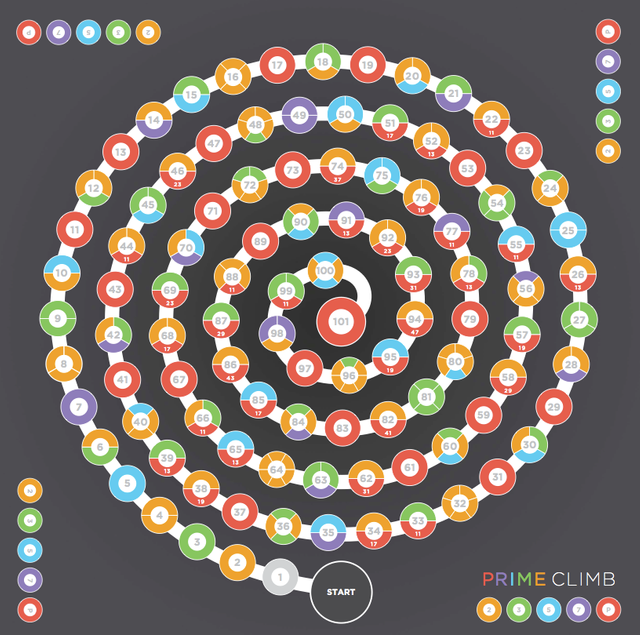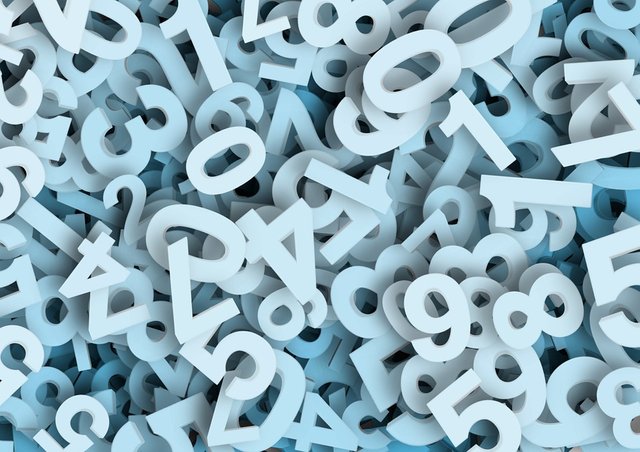My Overview Of The Math Boardgame Prime Climb
Hi there. In this post, I provide an overview of the math board game Prime Climb. I explain the game in the best way I can. If anything is wrong, refer to the references/resources section for the official rulings.

The Prime Climb game is a dice type board game where the numbers 0 to 101 (inclusive) are arranged in a spiral like fashion. In order to win, the objective is having both coloured pieces land on the number 101 (and not go past it). You need at least two players to play and the maximum number of players is four. The game comes with two ten sided dice, four pairs of coloured pieces and prime cards.
Math Prerequisites
Players should be comfortable with addition, subtraction, multiplication and division.
The Dice & Number Operations
There are two ten sided dice in the game. The numbers are labelled from 0 to 9 where 0 counts as ten. The numbers represent the number of spaces for a player piece which would move forward or backwards.
Number Operations
When it comes to number operations from the dice, you can add, subtract, multiply or divide using the numbers from the dice and the number(s) from the spaces where the pieces are. Moves from the two dice can be applied to one piece twice or each of the two pieces once (but with different number of movement spaces). This stuff is better explained with examples.
Example One
Piece one is currently on the number 6 and piece two is currently on the number 10. The two dice rolls are 7 and 3. Here are some options:
- Move piece one 7 and 3 places forward which would be 6 + 7 + 3 = 16.
- Move piece one from 6 to 42 as 6 times 7 is 42 and move 3 more to go from 42 to 45.
- Move piece one from 6 to 18 since 6 times 3 is 18 and move piece two from 10 to 17 (add 7) or from 10 to 70 (10 times 7).
- Move piece two back from 10 to 7 (10 - 3 = 7) and move piece two from 7 to 49 (7 x 7 = 49)
- Move piece one from 6 to 13 from addition of 7 and move piece two from 10 to 30 by multiplication of 10 and 3.
Example Two
Piece one is currently on the number 42 and piece two is currently on the number 100. The two dice rolls are 2 and 10. Note that you have to land on 101 but you cannot go past 101. As you cannot go past 101, you may have to subtract or divide. Here are some options:
- Move piece one 2 and 10 places forward which would be 42 + 2 + 10 = 54.
- Move piece one from 42 to 84 as 42 times 2 is 84 and move 10 more to go from 84 to 94.
- Move piece one ten spaces forward from 42 to 52 and move piece two two spaces backwards from 100 to 98.
Example Three
Piece one is currently on the number 74 and piece two is on the number 33. The two dice rolls are 3 and 8.
- Move piece one 8 places forward from 74 to 82 and move piece two from 33 to 99 (multiply by 3).
- Do 33 divided by 3 to get 11 and multiply by 8 to move piece two from 33 to 88.
- Move piece one eleven spaces forward from 74 to 85 (74 + 3 + 8 = 85).
- You can't use 11 from 3 + 8 and apply it to a piece.
Landing On Another Player's Space And Bumping
If you land on another player's space you can send that piece (even your own) back to the starting number of zero.
Landing On A Prime Number Greater Than 10 & Prime Cards
There are red circle spaces on the board which represent prime numbers from 10 to 101 (inclusive). Landing on a red prime number space allows the player to draw a random card.
If the card says KEEPER, the player can keep the card. A keeper card has to be shown face up on the table. Keeper cards cannot be used during the turn that is drawn and can be used during the piece move phase.
Action cards are cards that do not say KEEPER and must be played as they are drawn.
Each card has its own instructions and follow them accordingly.
The prime cards add a surprise and random element to the game to keep things fresh and exciting.

Don't Go Past 101!
The concept of not going past 101 is somewhat shown in one of the examples. At first, the concept of moving pieces backwards sounds weird but it can be used as a way to avoid going past 101 and/or for bumping other players' pieces.
The winner is the first player for having both pieces land on 101.
(No prime card is drawn after landing on 101.)
References / Resources
Thoughts
After four or five plays of the game, I thought it was an interesting and strategic game. The addition, subtraction, multiplication and division adds a lot of options for players with the decision making process of moving pieces. Having the ability of bumping opponent pieces off is neat as you can bump off pieces that are near 101 (which can really piss off people). The existence of prime cards adds an additional surprise element which can change the dynamic of the game.
Prime Climb's price is $49.99 CAD at Amazon.ca. I don't think this game is particularly for me as I am not a big board game fan and I can see myself getting bored after a week or so. I think this game is more suited for family game nights and for children from the ages of 10 to 14.
If you would like to support the educational community by delegating to @steemiteducation, please click on any of the following links. This will ensure that more teachers are supported on a daily basis.
100SP 200SP 300SP 400SP 500SP 750SP 1000SP 2000SP 3000SP 4000SP 5000SP 10,000SP 25,000SP